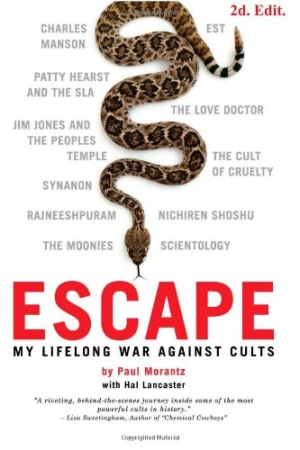Escape
My Life Long War Against Cults
An outline of techniques used by cult leaders vibrantly and cleverly offers insight into human nature.
Attorney Paul Morantz’s second edition of Escape: My Life Long War Against Cults is a fascinating distillation of forty years of tangling with off-kilter charismatic leaders, viper-wielding hit men, and other violent kooks.
The volume describes the rise and fall of the Moonies, Rajneeshees, Symbionese Liberation Army, and Church of Scientology, as well as Charles Manson and a herd of unlicensed and unethical psychotherapists. Most of the pages, however, deal with the complicated history of Synanon. This drug-addiction treatment group morphed into a paranoid, politically connected, paramilitary thug squadron that terrorized lower-rung members and neighbors through the 1960s and ‘70s. Morantz’s crusade against Synanon led to a near-fatal attack from a rattlesnake planted in his mailbox, though, ironically, the reptile may have ultimately saved his life, as he had tentative plans to go to Jonestown, Guyana, with the doomed congressional delegation a few months later.
Morantz effectively outlines the chillingly similar methods used by cults (he prefers the term “totalist movement”) to control thought and behavior. He has a sympathetic view of those manipulated by megalomaniac cult leaders because such methods are so effective at creating states of psychological rebirth and enlightenment in vulnerable people. He also warns that political leaders have the ability to utilize such techniques to manipulate public opinion, and points to American willingness to unravel long-held civil liberties and rush to war in the wake of 9/11.
Escape is an intense book delivered with a lot of panache. Morantz is a larger-than-life character, wielding vibrant prose as he describes his legal victories and sometimes out-of-the-box escapades to rescue clients and their assets from cult clutches. If there’s a healthy amount of swagger in his descriptions, it seems a pardonable offense given the courage and doggedness displayed in his long-running crusade.
The author’s many witty asides and turns of phrase are enjoyable. One of his childhood heroes was Captain Nemo from the film version of 20,000 Leagues Under the Sea. Morantz now lumps him in with other cult leaders, noting that “recently, a heroic and resourceful animated fish was named in his honor, which just proves that you can’t keep a good sociopath down.”
A reading list would be a welcome addition to provide references for the many sources Morantz mentions. While he states that his “aim was to make this the only book you’ll ever need to read on the subject,” those who wish to learn more about various aspects of cults and mind control will want to track down the other materials he mentions.
This is a timely and valuable book that should be required reading for psychology students and anyone interested in how individual and public opinion can be manipulated. It is packed with information about how cults work and why they are so dangerous, but Morantz relays this dense material with such passion and verve that the pages turn easily.
Reviewed by
Rachel Jagareski
Disclosure: This article is not an endorsement, but a review. The publisher of this book provided free copies of the book and paid a small fee to have their book reviewed by a professional reviewer. Foreword Reviews and Clarion Reviews make no guarantee that the publisher will receive a positive review. Foreword Magazine, Inc. is disclosing this in accordance with the Federal Trade Commission’s 16 CFR, Part 255.

